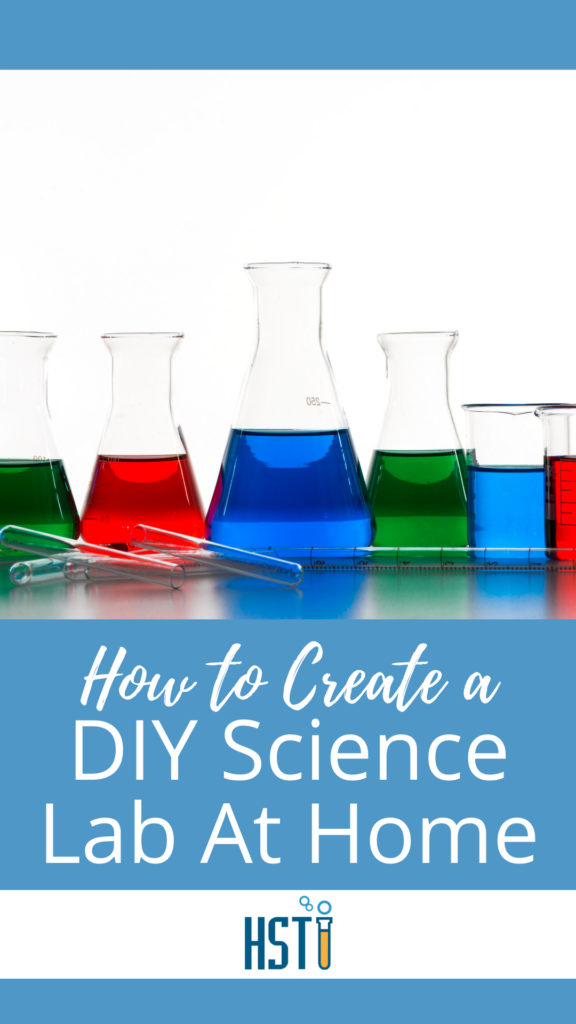A DIY science lab at home is a wonderful way to foster science curiosity — creating that desire to learn and experience science in your kiddos!
Building a science lab at home can be a bit of an intimidating thought, though. With the help of the tips you’ll find in this article and the supplies and resources provided by us here at Home Science Tools — you’ll come out confident and eager to get your science lab at home set up!
Dedicated Space for Your Science Lab
A dedicated space for your science lab at home doesn’t have to be a literal only-used-for-science-labs space. So if you’re limited on space in your home, there are still ways to create this. So, how do you pick a dedicated space?
- Pick a location that has good ventilation, to accommodate a variety of science experiments. This could be in your garage, in a room that has lots of windows, your back porch, or something along those lines.
- Pick a location that has good lighting. Or, get some extra lighting to plug in. Having good lighting is essential in your DIY science lab at home.
- Pick a location that you can easily access with good visibility. Depending on your kiddos ages, you may be able to safely watch from a distance while they do their lab work. But you still always want to be sure that you can check in visually to see how things are going for the ultimate lab safety.
The Basic Tools For Your Science Lab At Home
Before we get into your science supplies for your science lab at home, we need to get into the basic lab equipment. These are the things you need to get your science lab space set up!
- Surface area. Think table, counter, or something along those lines. A foldable table is a great option when the space you use for your science labs is a multi-purpose area. If your space is your garage, maybe you have a workbench in there that you can clear off for science programs, lab activities, and lab experiments.
- Storage bin or drawers. Most of your supplies should be put away in a box or storage bin of sorts if you don’t have a dedicated room for your science lab. And let’s face it, most of us don’t. This is for several reasons including safety and practicality. You can use actual bins or those plastic drawers you can find at just about any local store.
- Tarp, plastic mat, or plastic sheet to protect your floors or surface area if needed.
Supplies For Your Science Lab At Home
Supplies will vary by age group, interest, and science field of study. But in general, as an educator, you’ll want to try and keep a list of supplies on hand in addition to the ones you add on for specific upcoming experiments. Here are several to get you started:
- Balloons
- Corn Starch
- Baking Soda
- Alcohol
- Peroxide
- Toothpicks
- Photographic Periodic Table
- Tweezers
- Gloves — disposable or you can get reusable ones too.
- Goggles for kids and for adults
- Aprons
- Disposable shower caps
- Notebooks
- Pencils
- Colored Pencils
- Petri Dishes
- Calculator
- Beakers
- Food Coloring
- Dropper
- Glassware
- Lab coats (or an old, oversized long-sleeved shirt as a make-shift lab coat!)
When you get to high school and begin doing more specific lab experiments, be sure to visit our store here for everything you’ll need! (We also carry stuff for younger ages, too.)
Extras For Your Science Lab At Home
Science kits are a super fun thing to have on hand. You can have just a few or a whole shelf lined up with them. These also make for some wildly fun gifts on birthdays or holidays. Something I love about kits is that they usually come with extra supplies too — which help you either do a repeat of the experiment or build up your supplies! Here are some to consider:
- Complete Introduction to Chemistry Kit
- Chemistry Lab Equipment Set
- Weather Experiment Kit
- Bacteria Hand Washing Experiment Kit
These lab kits are super handy and give you the flexibility to do an experiment anytime the mood hits- in real-time!






